Content [show]
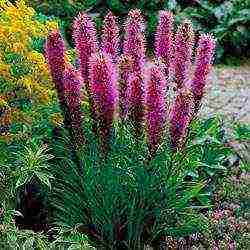 Each flower has its own benefits. For some it is a scent, for others - useful properties, for others - external beauty, for the fourth - it is simplicity and unpretentiousness in planting and growing in open ground, a variety of varieties. And there is a flower that combines all of the above. This is a handsome Liatrice.
Each flower has its own benefits. For some it is a scent, for others - useful properties, for others - external beauty, for the fourth - it is simplicity and unpretentiousness in planting and growing in open ground, a variety of varieties. And there is a flower that combines all of the above. This is a handsome Liatrice.
Features and varieties of liatris
Liatris is shaped like a candle. The multi-leaved straight stem ends with a bright rosette of inflorescences, which, at the moment of flowering, seem to "light up" with different colors. A flower blooms from the top, resembling panicle tassels.

Liatris is very reminiscent of delicate and romantic wildflowers
The subtle aroma of Liatrice is reminiscent of vanilla with subtle, subtle notes of hay. The thing is that the leaves of Liatris contain coumarin, which is widely used in perfumery. Liatris is also actively used by cosmetologists, because its broth has a high tonic effect. It is widely known that this flower helps with kidney diseases, and as a medicine against malaria and even sexually transmitted diseases. Root lotions help with wound healing.
The most popular are three types of this flower:
Spikelet liatris. This species reaches a height of 80 cm, its stems are densely covered with leaves, and the inflorescences come in 6 different colors: purple, lilac, pink, violet, azure and, which is considered the rarest, white.
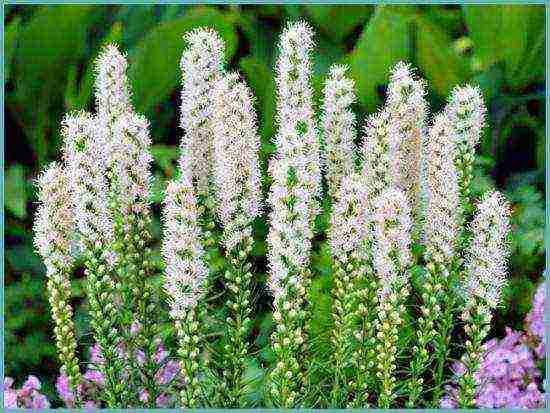
Liatris spikelet white
Filmy liatris. Bright pink or white "candles" of this type of liatrix can reach a meter in height. Differs in very wide leaves.
Grungy Liatrice... The tallest member of the family. Its height reaches two meters. Its purple small flowers are collected in fluffy panicles.
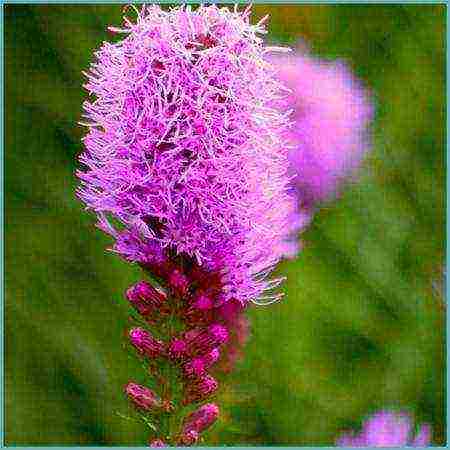
Grungy Liatrice
Liatris is jokingly called the flower of lazy people, because it is unpretentious in care and is not susceptible to disease. Besides all this, Liatris is a wonderful honey plant. This flower is also great for cutting. Flowers can stand in a vase for up to two weeks.
How to plant Liatrice
When planting liatris in the open field, it should be remembered that the flower feels best in a well-lit place: it is not afraid of direct sunlight. But the shadow can adversely affect the shades of inflorescences, the growth and development of culture. Therefore, he should be given the sunniest place on your site, for which he will certainly thank you with all the variety of his flowers and fluffy bushes.
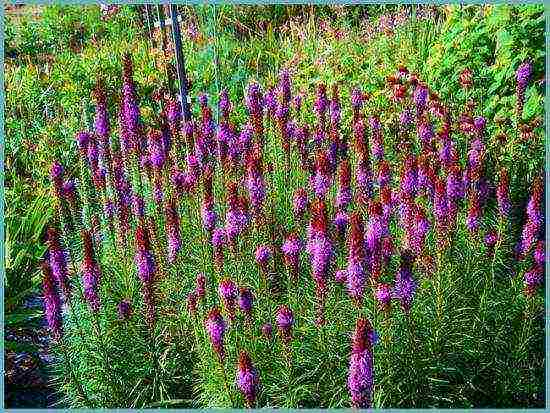
Bicolor liatris
You can plant liatris in open ground with tubers or seeds. Planting with seeds is recommended as follows:
- Sow flower seeds in a cold greenhouse or directly into open ground in late March or early April.
- Seedlings that will sprout are grown until mid-autumn, and after that, when the greens die off, the tubers are dug up and stored with the ground until mid-spring.
- Then they are planted in a prepared place.

The sprouts of Liatris before disembarking to a permanent place
Liatris prefers dry soil, without the proximity of groundwater. The plant does not tolerate heavy clay soils.
Suitable care
Caring for a lyatrix is not a big hassle. It is enough to water the plant as needed when the ground around the bush is dry. In most cases, the rains are enough for the lyatrix.Abundant watering can lead to rotting of the flower.

Liatris requires minimal maintenance
Closer to autumn, when the liatris finishes flowering, the corollas of the inflorescences are cut off so that the wind does not spread the seeds throughout the site. And at the end of the season, the plant is cut to the root and covered for the winter with a 10-15 cm layer of humus or foliage so that the tubers do not freeze in frost. Frosts below -5 C can harm the plant. So if winters in your area are frosty and snowless, then it is better to cover the plant in autumn. If the climate is temperate, then liatris will be able to winter without shelter.
Top dressing and fertilization
Liatris is fed three times a season with phosphate-potassium fertilizers. If you notice that the leaves of the flower have begun to fade, it is worth feeding the bush with nitrogen fertilizer. Liatris no longer needs any fertilizers. Just add a little earth to it, because the tubers are close to the surface and can be washed out by rains. For the same reason, weeding of lyatris must be done with care. Many gardeners recommend not weeding at all, but limiting ourselves to mulching.

Liatris will feel more comfortable if the soil is mulched
Reproduction of Liatris
Liatris can be propagated by tubers and division.
If you already have bushes older than three years on the site, then take the tubers directly from their roots for propagation. Tubers must be chosen with a diameter of at least 2 cm. They are planted in a hole of 8-12 cm, one-third filled with humus.
Attention. Before planting a tuber, carefully inspect it and find a depression. This will be the top side of the tuber. If the groove is not visible anywhere, then it is better to plant the tuber sideways.
The second method of breeding lyaris is no more difficult. It is necessary to separate the young growth from the mother bush. Choose shoots that already have a hardened root collar with tubers. Plant the shoots in the holes, the intervals between which should be at least 30-40 cm, fill the hole with humus by a third.

Corm lyatrice
Liatris is transplanted either in early spring or late autumn, and no more than once every 3-4 years. The transplanted bushes bloom the next summer.
Diseases and pests
Liatris, planting and caring for which does not bring any hassle, is also not susceptible to disease. However, this does not give him immunity from pests such as the bear. As well as from other insects that prefer to feed on garden plants.

Snails can significantly damage the Liatris root system
Also, snails and even field mice can show an increased interest in the roots of liatris. Therefore, it is worthwhile to take all measures in advance that will help prevent such attacks on your plants. The resistance to diseases in liatris is still poorly determined, but cases are known when leaf diseases were transmitted to liatrix from infected plants growing in the vicinity.
Liatris: combination with other plants
Liatris gets along well with other perennials that prefer sunny areas with loose soil and tolerate drought better than excess moisture. Liatris also grows amicably with field specimens, gypsophila, chamomile and other flowers.
Liatris in landscape design
In general, liatris is a very harmonious flower. The main thing is to choose the right neighbors for him in the garden, paying attention to the height, color and flowering period.
Liatris in snow-white or purple shades is perfect for creating expressive compositions with double red-orange daylilies or yellow evening primrose. Hosts with their lush inflorescences look picturesque next to the lyatrix.
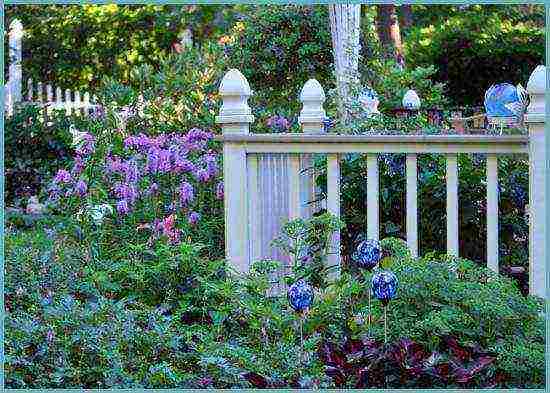
Liatris is very often used to decorate parks and squares.
Variety "Picador", which is the owner of bright red-purple inflorescences, will perfectly contrast with the snow-white bells and delphinium. It also goes well with stock roses and pale pink mallow.
In mixed-type flower beds, white liatris will look very beneficial together with purple and red monards or cherry yarrow.
Attention. The white Liatris variety is considered the most finicky, and does not often grow into a fluffy bush.
Low-growing varieties of Liatris, planting and caring for which is the easiest, look amazingly harmonious in rockeries among strong boulders. The most suitable variety for rockeries is "Kobold", which grows no higher than 40 cm and is the owner of bright purple-lilac and purple inflorescences. In rockeries, it will serve as an excellent background for blue-gray fescue with a Carpathian bell, shading and complementing them.
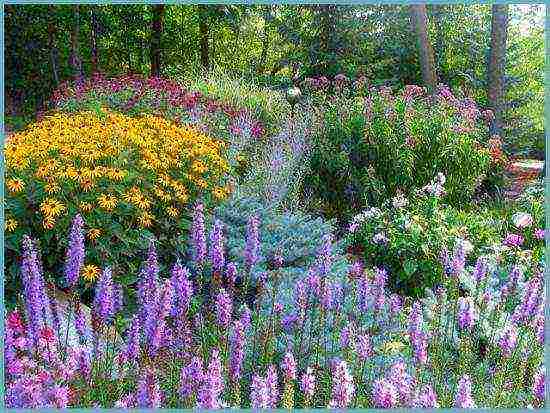
Landings contrasting in color look beautiful
Another option for using liatris in landscape design can be longitudinal plantations - along house buildings, flower beds or fences.
Advice. Plant liatris along the line of the sun, whichever landscaping option you choose.
Liatris came to our gardens from North America relatively not so long ago, therefore he can rarely be found in the flower beds of neighboring gardeners. However, such underestimation of this flower is completely unjustified. Indeed, in addition to easy cultivation, unpretentiousness in care and watering, this flower has an excellent aroma and original look. He is increasingly seen on wedding photos in a bridal bouquet. Liatris begins to take pride of place in flower beds and rockeries. Having grown these plants in your flower garden, you will not regret it, and maybe someone will come to visit you to take a photo against the background of your amazing flower bed with lyatris.
Unpretentious Liatrice: video
Liatris: photo
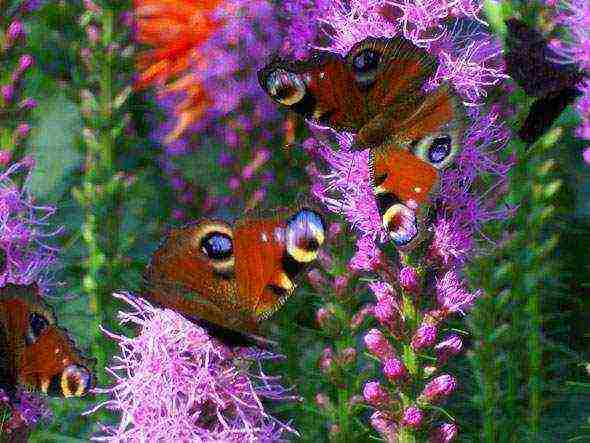
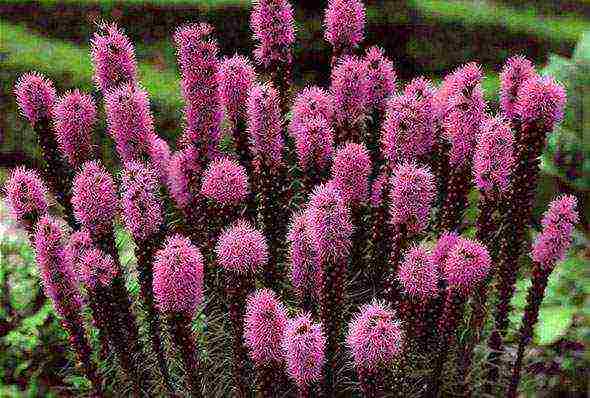
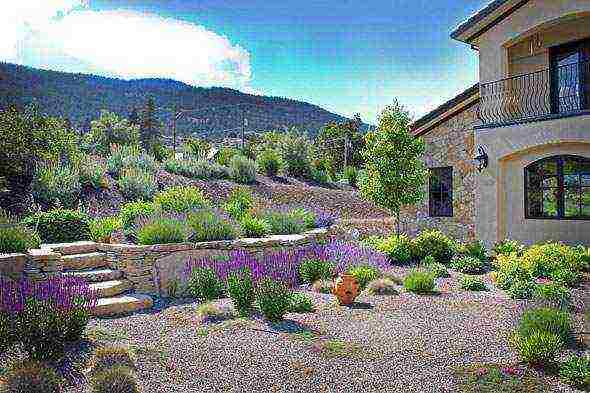



 In many garden plots, you can find such an amazing plant as liatris, which looks very beautiful both in the photo and in person. This decorative flower has a pleasant aroma and unusual flowering, moreover, it is not capricious. Planting Liatris on time will allow you to enjoy the original flowers from the beginning of July to the end of August.
In many garden plots, you can find such an amazing plant as liatris, which looks very beautiful both in the photo and in person. This decorative flower has a pleasant aroma and unusual flowering, moreover, it is not capricious. Planting Liatris on time will allow you to enjoy the original flowers from the beginning of July to the end of August.
This perennial has a large number of different varieties, planting seeds of which and caring for sprouts does not require much effort. Thanks to this, this culture is considered quite popular. Let's try to figure out what a liatris is, planting and care in the open field of which will also be considered.
Variety of varieties
 The homeland of Liatrice flowers is North America, so it takes root well in our country. It is a perennial plant erect erect stem, which is decorated with numerous inflorescences, and in height it can reach 2 meters. Many gardeners plant the plant in groups, which looks very beautiful. It is also planted in separate flower beds and is often used for bouquets. To keep it in the vase longer, the water is diluted with a small amount of fertilizer.
The homeland of Liatrice flowers is North America, so it takes root well in our country. It is a perennial plant erect erect stem, which is decorated with numerous inflorescences, and in height it can reach 2 meters. Many gardeners plant the plant in groups, which looks very beautiful. It is also planted in separate flower beds and is often used for bouquets. To keep it in the vase longer, the water is diluted with a small amount of fertilizer.
This plant is represented by varieties, the number of which is more than forty. The most common types are:
- spicate;
- filmy;
- rough.
Spikelet is the most common type of liatris, the height of adult inflorescences in which is 80 cm... It begins to bloom in late June and lasts until mid-July. The shades of this species are quite diverse. Liatris spikelet blue (bluish color) goes well with white, purple lilac, pink and purple flowers.
Filmy. A distinctive feature of this species is the leaves, which can reach a width of 3 cm. Some varieties can reach a height of one meter. The most popular variety of this species is "Alba", which has white fluffy inflorescences. It is very easy to care for it, just like planting and growing.
Rough - this variety is tall, the stems of some varieties can reach a height of 2 meters. The upper part of the stem is strewn with small purple flowers, which are collected in lush inflorescences.
Methods for growing Liatris at their summer cottage
This culture can multiply:
- seeds;
- tubers;
- dividing the bush.
Planting a plant is carried out in different ways and it depends on which method is chosen.
Growing liatris from seeds in the open field
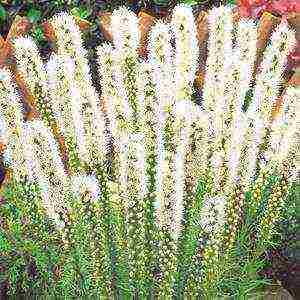 This method is considered the simplest, and adult flowers can be obtained in the second year. Since seedlings are not afraid of frosts, many gardeners sow them in the ground in late autumn... Still, it's better to do it in the spring. A place for growing a crop is prepared in advance by digging it up and applying fertilizer (1 bucket of humus per 1 m2).
This method is considered the simplest, and adult flowers can be obtained in the second year. Since seedlings are not afraid of frosts, many gardeners sow them in the ground in late autumn... Still, it's better to do it in the spring. A place for growing a crop is prepared in advance by digging it up and applying fertilizer (1 bucket of humus per 1 m2).
The seeds need extra care. Before planting, they should be soaked for 8-10 hours in plain water or in a growth stimulator. Seeds are planted in holes with a depth of 1 to 1.5 cm. As soon as they are planted, the beds are evenly covered with soil.
Reproduction of Liatris tubers
This method is ideal for those who have an adult plant on their site, for which they provide the necessary care. Tubers as planting material are best taken from flowers that are more than three years old. When placing them in the ground, you should find a small depression on the tubersfrom which shoots will sprout. They are planted in pre-prepared pits with a depth of 10 cm, a third of which must be filled with humus. If everything is done correctly, then the first shoots can be expected in about a month.
Dividing the bush
In this case, young shoots of an adult plant, together with roots, are used as planting material. The bush is divided in such a way that the young shoot has a powerful part of the mother plant and it can root well.
For planting such shoots, holes are prepared with a depth of 10 - 20 cm, located at a distance of 30 cm from each other. The well, as in the previous case, is filled with humus by 1/3, after which this culture is planted. After all the shoots are planted, the beds should be mulched using humus. Further Liatrice transplanted in early spring or at the end of autumn. Reproduction in this way must be carried out every 3-4 years.
Care
If this flower is planted in open ground, then caring for it is as follows:
- regular watering;
- weed removal;
- hilling a bush.
Since the root system of Liatris is superficial and can be exposed during rains, it should be regularly added to the soil on the site. Tall peduncles sometimes need to be tied to a support. It is also advisable to mulch the site, in this case the roots will be protected and receive additional nutrition.
Liatris needs to be fertilized regularly. Doing so recommended 12 times a week and it is best to combine this with watering, which at the beginning of the growing season contributes to the formation of a powerful root system. But do not moisten the plant too much, as in this case the roots can rot.
It is necessary to feed liatris with fertilizers in the spring, which are purchased in a specialized store. Excessive feeding can lead to the fact that thorns will fall off the flower. Also, caring for the plant consists in weeding and removing dried inflorescences so that the flower does not lose its decorative effect even after its flowering and delights the eye with its bright green foliage for a long time.
Diseases and pests
 Liatris is unpretentious and resistant to various diseases, but they can greatly harm him snails and bears... To get rid of them, you need to use the following folk method: a 100 ml bottle of beer is dug into the ground at an angle of 45 degrees so that the neck is 2 - 3 cm below the surface level.Snails and bears will crawl to the smell of beer, as a result trapped. It is only necessary to regularly change the beer in the baits.
Liatris is unpretentious and resistant to various diseases, but they can greatly harm him snails and bears... To get rid of them, you need to use the following folk method: a 100 ml bottle of beer is dug into the ground at an angle of 45 degrees so that the neck is 2 - 3 cm below the surface level.Snails and bears will crawl to the smell of beer, as a result trapped. It is only necessary to regularly change the beer in the baits.
Sometimes from waterlogging the plant begins to rot.In this case, all rot is cut off on the flower, after which it is treated with a fungicide.
Thus, we have sorted out what liatris is, its features, a photo of this flower was presented in the article. This exotic plant takes root well in Russian household plots, as it resistant to various adverse conditions... The process of growing from seeds is quite simple and even a novice gardener can handle it.
Spikelet liatris
 Liatris with fluffy candle inflorescences and a wonderful aroma is a popular decorative perennial for summer cottages. If among the favorite plants of the grower there is liatris, planting and care in the open field are important steps towards its long life and stable flowering.
Liatris with fluffy candle inflorescences and a wonderful aroma is a popular decorative perennial for summer cottages. If among the favorite plants of the grower there is liatris, planting and care in the open field are important steps towards its long life and stable flowering.
Tall liatrix with erect stems, narrow leaves and spike-shaped inflorescences of all shades from snow white to dense purple, one of the most visible plants in garden beds. Natives of the American continent, they are unusually unpretentious, responsive to care, can propagate by seeds and vegetatively, by dividing tuberous rhizomes.
Planting Liatris in open ground with seeds
 Many ornamental plants can only be grown through seedlings. It is quite laborious and requires a lot of effort, time and attention. Liatris is a happy exception. Seeds germinate well already in the garden, do not require special preparation, except for soaking in a solution of potassium permanganate.
Many ornamental plants can only be grown through seedlings. It is quite laborious and requires a lot of effort, time and attention. Liatris is a happy exception. Seeds germinate well already in the garden, do not require special preparation, except for soaking in a solution of potassium permanganate.
Seed planting of Liatris in open ground is carried out in the spring, when the ground thaws. In the middle lane, a suitable period lasts from late March to mid-April. Until autumn, young plants will have time to develop enough to start an independent life in a flower bed in spring.
Sowing is carried out in pre-dug nutrient soil to a depth of 1 to 1.5 centimeters. When the furrows are covered, the ridge is watered. Seedlings during the whole warm season need:
- in regular but moderate watering;
- in weeding the soil next to the seedlings;
- in gentle loosening of the soil surface.
 To save time on weeding, in the spring, after planting Liatris in open ground, the crops are mulched. If it rains in summer, the plants are not specially watered. Excess moisture can cause rotting of small tubers and rhizomes.
To save time on weeding, in the spring, after planting Liatris in open ground, the crops are mulched. If it rains in summer, the plants are not specially watered. Excess moisture can cause rotting of small tubers and rhizomes.
In autumn, young liatrices lose their aerial part. This is a signal for the grower to dig up the tubers and store them until spring.
Planting Liatris in open ground with bulbs
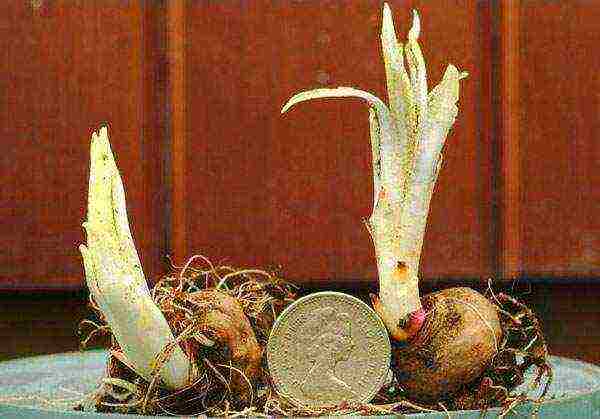 The decorative perennial grows up and blooms rather late. The first candles above the narrow built-up foliage appear only in the second or third year. If there are already large clumps of this plant on the site or planting material was bought in a store, planting liatris in open ground with bulbs is carried out in the second half of summer. The right time is after flowering, in August or September.
The decorative perennial grows up and blooms rather late. The first candles above the narrow built-up foliage appear only in the second or third year. If there are already large clumps of this plant on the site or planting material was bought in a store, planting liatris in open ground with bulbs is carried out in the second half of summer. The right time is after flowering, in August or September.
Perennials older than three years of age are suitable for reproduction. In August:
- the plants are dug up;
- corms larger than two centimeters are separated;
- the resulting planting material is planted in a suitable place in 8–10 centimeter holes with loose soil mixed with humus.
 The bulbs are planted with a deepening upward, then covered with a layer of soil, which is compacted, watered and mulched. A gap of at least 30–40 cm is left between the holes, so that young flowers have plenty of space and nutrition. After planting, care for Liatrix outdoors is limited to mulching and weeding.
The bulbs are planted with a deepening upward, then covered with a layer of soil, which is compacted, watered and mulched. A gap of at least 30–40 cm is left between the holes, so that young flowers have plenty of space and nutrition. After planting, care for Liatrix outdoors is limited to mulching and weeding.
If the fall is dry, the ridge can be watered. For the winter, such plantings are abundantly covered with mulch, spruce branches or other material.
If desired, liatris can be planted not with separate corms, but with parts of an adult, overgrown bush. The main thing is that the delenki have:
- own roots;
- formed tubers;
- healthy growth points.
Planting holes are made to the size of the separated part of the bush, and then, for quick rooting, they are filled with a loose nutrient mixture based on garden soil and humus.
Landing site for Liatris in the open field
 To simplify the care of lyatrix after planting in the open field, it is important to choose a place suitable for the culture, while you need to pay attention not only to the decorative qualities of the perennial, but also to its requirements for soil, lighting and other growing conditions.
To simplify the care of lyatrix after planting in the open field, it is important to choose a place suitable for the culture, while you need to pay attention not only to the decorative qualities of the perennial, but also to its requirements for soil, lighting and other growing conditions.
 Liatris is a large decorative perennial, which has one of the main roles in the flowerbed.
Liatris is a large decorative perennial, which has one of the main roles in the flowerbed.
The plant will look great against the background of trees, large coniferous shrubs, next to decorative deciduous species and in the background of low or ground cover flowering plants.
 The liatris planting site must be sunny. The plant is not afraid of wind, direct midday rays and summer heat. But dense soil, especially oversaturated with moisture, is a risk factor. If a similar site is chosen for planting liatris, in the photo, care in the open field will be complicated due to decay of the root system and the development of fungal diseases.
The liatris planting site must be sunny. The plant is not afraid of wind, direct midday rays and summer heat. But dense soil, especially oversaturated with moisture, is a risk factor. If a similar site is chosen for planting liatris, in the photo, care in the open field will be complicated due to decay of the root system and the development of fungal diseases.
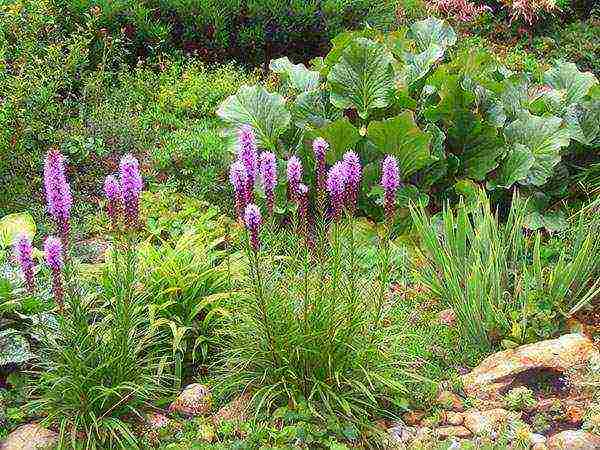 If melt or rain moisture accumulates in the summer cottage, groundwater lies close, a drainage layer and a drainage system must be provided under the flower bed.
If melt or rain moisture accumulates in the summer cottage, groundwater lies close, a drainage layer and a drainage system must be provided under the flower bed.
Caring for Liatrix after planting in open ground
 Liatris is surprisingly unassuming and can rightfully bear the title of "flower for lazy summer residents." Flower care consists in watering, removing weeds and loosening the soil. Young liatrixes require the most attention. As soon as the bush grows, the leaf rosette overlaps a significant area of the soil, retaining moisture in it and preventing weed sprouts from rising.
Liatris is surprisingly unassuming and can rightfully bear the title of "flower for lazy summer residents." Flower care consists in watering, removing weeds and loosening the soil. Young liatrixes require the most attention. As soon as the bush grows, the leaf rosette overlaps a significant area of the soil, retaining moisture in it and preventing weed sprouts from rising.
In dry times, liatrix is watered moderately. It is important that the water flow is not strong and does not erode the soil, exposing the surface root system. If this happens, it is necessary to spud the flower or pour fresh substrate under the base.
Liatris is fed three times during the warm season. In the spring, the flower receives nitrogen stimulating the growth of greenery. In the summer, the flower is fertilized twice with potassium-phosphorus mixtures, pushing flowering and preparing the plant for a dormant period.
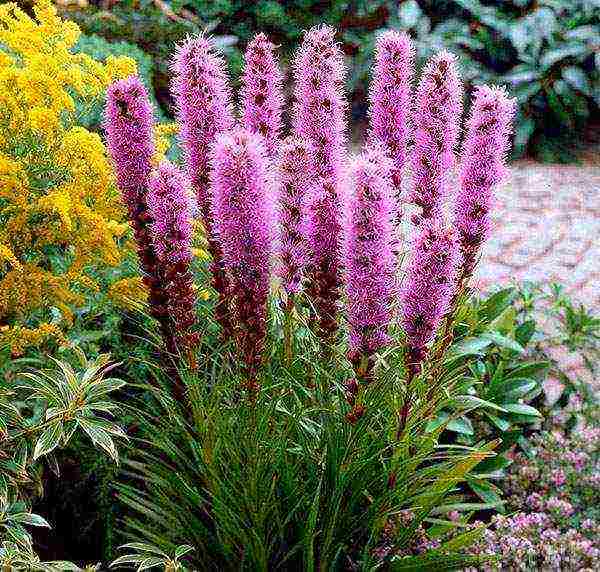 Supports are provided for tall plants. And after wilting, the inflorescences are cut off. If this is not done, the lyatrice will not miss the opportunity to scatter and seize part of the area not due to him. The preparation for winter does not end there. The plant is winter-hardy, but sudden autumn colds, for example, when planting and caring for lyatrix in the open field in the Urals or other regions with a harsh climate, can seriously harm the culture. Therefore, the above-ground part, when the leaves turn yellow and dry, is cut off in advance, and the site is thickly mulched with a layer of about 15 cm. The shelter is most important if the winter is snowless.
Supports are provided for tall plants. And after wilting, the inflorescences are cut off. If this is not done, the lyatrice will not miss the opportunity to scatter and seize part of the area not due to him. The preparation for winter does not end there. The plant is winter-hardy, but sudden autumn colds, for example, when planting and caring for lyatrix in the open field in the Urals or other regions with a harsh climate, can seriously harm the culture. Therefore, the above-ground part, when the leaves turn yellow and dry, is cut off in advance, and the site is thickly mulched with a layer of about 15 cm. The shelter is most important if the winter is snowless.
Reproduction of Liatris - video
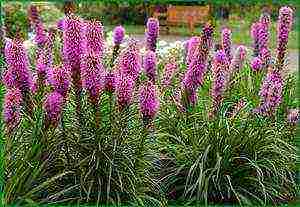 Flower Liatris (lat.Liatris) belongs to the genus of herbaceous perennial flowering plants from the Asteraceae or Asteraceae family, which mainly grow naturally in the Bahamas, North America and Mexico. There are approximately 20 species of liatris in their natural habitats. The name of the plant is formed by combining two words from the Greek language, which in translation mean "smooth" and "doctor". In our country, these amazing flowers are sometimes called "Funny feathers" or "Deer tongue".
Flower Liatris (lat.Liatris) belongs to the genus of herbaceous perennial flowering plants from the Asteraceae or Asteraceae family, which mainly grow naturally in the Bahamas, North America and Mexico. There are approximately 20 species of liatris in their natural habitats. The name of the plant is formed by combining two words from the Greek language, which in translation mean "smooth" and "doctor". In our country, these amazing flowers are sometimes called "Funny feathers" or "Deer tongue".
 Liatris in the garden culture is grown not so much because of the indisputable beauty of its candles-inflorescences, but for the sake of its enchanting, amazing smell, which combines notes of fresh hay and the subtlest aroma of vanilla. A person is attracted by the smell of Liatrice, but the mole cannot stand it catastrophically: just one sprig of liatris, which is in your closet, is able to prevent the attacks of the impudent insect on your woolen things.
Liatris in the garden culture is grown not so much because of the indisputable beauty of its candles-inflorescences, but for the sake of its enchanting, amazing smell, which combines notes of fresh hay and the subtlest aroma of vanilla. A person is attracted by the smell of Liatrice, but the mole cannot stand it catastrophically: just one sprig of liatris, which is in your closet, is able to prevent the attacks of the impudent insect on your woolen things.
Content
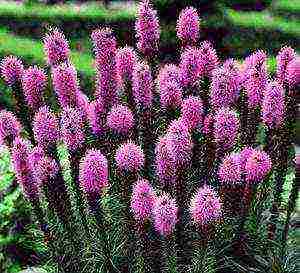 Spikelet liatris is perennial rhizome plantwhich has branched or simple erect stems. These stems are densely covered with whorled, linear, pointed leaves. The roots of the plant have a tuberous shape that resembles bulbs connected by thin roots to each other. Spikelet liatris, with good care and proper location, can reach a height of two meters.
Spikelet liatris is perennial rhizome plantwhich has branched or simple erect stems. These stems are densely covered with whorled, linear, pointed leaves. The roots of the plant have a tuberous shape that resembles bulbs connected by thin roots to each other. Spikelet liatris, with good care and proper location, can reach a height of two meters.
White, red, pink, violet-purple and reddish-purple tubular flowers form baskets, which, in turn, make up racemose or spike-shaped inflorescences, reaching a length of one and a half meters. A flower in the open field blooms in summer, and the main difference between the flowering of liatris and the flowering of other ornamental plants is that the process begins not from the bottom, but from the upper part of the inflorescence. Liatris fruits are ribbed elongated achenes that are covered with pile.
Liatris is actively used in landscape design or as a standalone plant, although it will look just as great in combination with flowers from this list:
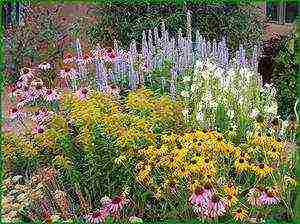 thrift;
thrift;- phlox;
- verbena;
- brunner;
- gypsophila.
Liatris flower stalks stand perfectly in the cut for up to 10 days, and those inflorescences that have already dried can be used to create winter bouquets.
Growing from seeds
Reproduction of Liatris can be carried out reckless and seedling methods, however, the flower is so cheerful, cold-resistant and unpretentious that there is little point in spending your efforts and time to grow seedlings. Usually, seeds are planted before winter or directly in open ground in early spring. This can be done safely, because seeds are not afraid of frost, however, before planting, they should be soaked in a humate solution for about half a day.

The earth must first be dug up with organic matter, after which a bucket of humus is added to it for one square meter of the planting area. The grooves for the planting material should be 1-1.5 cm deep. The seeds are distributed evenly along the furrow, then lightly sprinkled with soil and watered.
The flower grower who preferred the seed planting of liatris should know that the flower will enter full bloom and full growth only by the second, or even the third year of the growing season. Liatris, in addition, produces abundant self-seeding in the fall, so you only have to thin out the seedlings in the spring.
Landing Liatrice
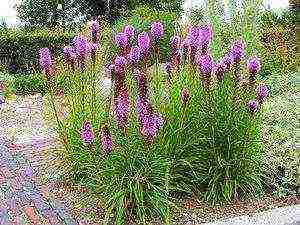 Perennial liatris is easiest to reproduce in a vegetative way. In the event that there is already liatris on your site, then you can try to get planting material from the plant. This can be done in September or August, by dividing the flower tuber into parts. You can also buy Liatris planting material in flower shops.
Perennial liatris is easiest to reproduce in a vegetative way. In the event that there is already liatris on your site, then you can try to get planting material from the plant. This can be done in September or August, by dividing the flower tuber into parts. You can also buy Liatris planting material in flower shops.
However, first of all, it is necessary to choose an area where the plant will be most comfortable - this is perhaps the first point in the proper care of an ornamental plant. A sunny, open area is great.... Direct rays do not harm the plant, just like high temperatures, to which liatris is indifferent, so you can not worry that the flower will not be able to withstand the July heat.
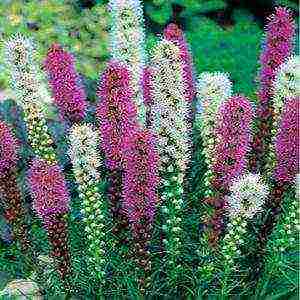 Liatris prefers well-drained, loose and nutritious soil. But what the flower is definitely afraid of is an excess of moisture in the root system, from which all the roots quickly rot, therefore raw heavy substrates, as well as areas in hollows, lowlands and other places with a close occurrence to the surface of groundwater, are not suitable for liatris ...
Liatris prefers well-drained, loose and nutritious soil. But what the flower is definitely afraid of is an excess of moisture in the root system, from which all the roots quickly rot, therefore raw heavy substrates, as well as areas in hollows, lowlands and other places with a close occurrence to the surface of groundwater, are not suitable for liatris ...
Planting liatris should be done in autumn or early spring.... Tubers are planted, depending on size, to a depth of 3 to 10 cm.It is very important to observe the distance between adjacent specimens of 15-20 cm.After planting, the flower must be watered, and then the area with the plant must be mulched with humus.
Caring for Liatrix
Caring for a flower consists in proper watering, timely removal of weeds, periodic hilling of the bushes of the plant instead of loosening the soil, because the root system of the liatris is superficial and after prolonged rains it gradually becomes bare. For the same reason, there is a need to add soil to the site. Flower-bearers of great height sometimes need to be tied with threads to a support.
 Do not in any way neglect mulching the plot... This procedure helps nourish and protect the roots of the plant, which greatly reduces the laboriousness of caring for the lyatrix.
Do not in any way neglect mulching the plot... This procedure helps nourish and protect the roots of the plant, which greatly reduces the laboriousness of caring for the lyatrix.- Among other things, the plant it is necessary to regularly feed with mineral fertilizers... Top dressing is applied up to three times per season: in the spring the flower needs nitrogen fertilizers, and in the summer - in phosphorus-potassium fertilizers.
- Also recommended cut off those Liatrice inflorescences that have long fadedso that the plant retains its decorative appearance and, even after flowering, still delights the eye with its bright foliage.
Liatris transplant
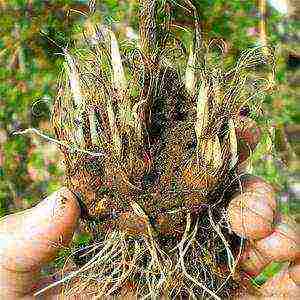 Plant transplantation must be done, as a rule, in autumn, simultaneously with dividing tubers about once every 3-4 years. We dig out the liatris, carefully divide the bush into parts so that each of such divisions has a root collar and tubers. Then the cuttings must be planted in the holes approximately at a distance of 30-40 cm between the crops. We deepen the tubers into the ground by 8-15 cm. A third of the hole should be covered with humus, and then the rest of the garden soil should be supplemented and the substrate should be properly tamped. After watering, it is recommended to mulch the area with humus.
Plant transplantation must be done, as a rule, in autumn, simultaneously with dividing tubers about once every 3-4 years. We dig out the liatris, carefully divide the bush into parts so that each of such divisions has a root collar and tubers. Then the cuttings must be planted in the holes approximately at a distance of 30-40 cm between the crops. We deepen the tubers into the ground by 8-15 cm. A third of the hole should be covered with humus, and then the rest of the garden soil should be supplemented and the substrate should be properly tamped. After watering, it is recommended to mulch the area with humus.
Diseases and pests
As you can see, leaving and planting Liatris in open ground is not burdensome and very simple. Even a novice florist will be able to cope with such tasks. However, Liatris is as unpretentious as it is resistant to diseases, which is good news. Only snails and bears can harm this plant.
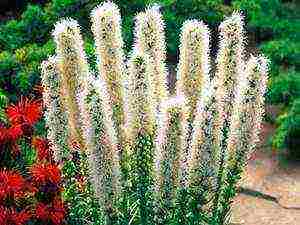 In the fight against insects, the following popular method is successfully used: we dig into the ground at an angle of 45 ° C a bottle containing 100 ml of beer, while the neck must necessarily be a couple of centimeters lower than the surface level. Snails and bears will crawl to the smell of beer and will be trapped. The main difficulty of this method is that it is necessary to regularly change the beer in the bait, since the drink fizzles out over time.
In the fight against insects, the following popular method is successfully used: we dig into the ground at an angle of 45 ° C a bottle containing 100 ml of beer, while the neck must necessarily be a couple of centimeters lower than the surface level. Snails and bears will crawl to the smell of beer and will be trapped. The main difficulty of this method is that it is necessary to regularly change the beer in the bait, since the drink fizzles out over time.
Sometimes a plant may start to rot due to waterlogging... In this case, it is necessary to cut off all the affected areas on the ground part of the ornamental plant, and then treat the green pet with a fungicide. In the event that the cause of the disease is that the flower is very close to groundwater or the soil is too heavy for the plant, you should seriously think about transplanting the liatris to another, more favorable area for it.
Liatris after flowering
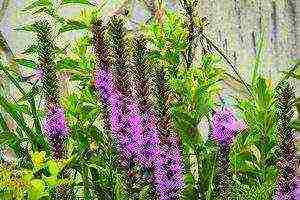 After the end of the flower period, the leaves of the lyatris will first turn yellow and then fall off. We cut off the ground part of the plant, and mulch the area with a layer of compost, dry grass, peat or spruce branches. Such a layer should be at least 10-15 cm. It is not recommended to use straw as mulch, because various field rodents very often like to nest in it, which feed on the rhizome of liatris in the winter season. In the event that winters in your region are not distinguished by severity, liatris will feel great even without shelter.
After the end of the flower period, the leaves of the lyatris will first turn yellow and then fall off. We cut off the ground part of the plant, and mulch the area with a layer of compost, dry grass, peat or spruce branches. Such a layer should be at least 10-15 cm. It is not recommended to use straw as mulch, because various field rodents very often like to nest in it, which feed on the rhizome of liatris in the winter season. In the event that winters in your region are not distinguished by severity, liatris will feel great even without shelter.
Varieties and types of Liatris
Culturally, it is customary to grow three types of liatris: rough, scarious and spikelet.
 Spikelet liatris (Liatris spicata)... The plant is native to the Southeast of North America. It has highly leafy stems that reach only 50 cm in height. Leaves are linear. In spike-shaped inflorescences, which reach 35 cm in length, small baskets are collected, which consist of 8-13 tubular flowers.The flowering period begins in July or June and lasts about 35-40 days. Culturally, the flower has been known since 1732. The most famous varieties of spikelet liatris are Kobold - 40 cm in height, pink-purple inflorescences; Floristan violet - 80 cm in height, purple inflorescences; Floristan Weiss - 90 cm tall, old flowers.
Spikelet liatris (Liatris spicata)... The plant is native to the Southeast of North America. It has highly leafy stems that reach only 50 cm in height. Leaves are linear. In spike-shaped inflorescences, which reach 35 cm in length, small baskets are collected, which consist of 8-13 tubular flowers.The flowering period begins in July or June and lasts about 35-40 days. Culturally, the flower has been known since 1732. The most famous varieties of spikelet liatris are Kobold - 40 cm in height, pink-purple inflorescences; Floristan violet - 80 cm in height, purple inflorescences; Floristan Weiss - 90 cm tall, old flowers. Grungy Liatris (Liatris aspera)... A rather rare species that has small lavender-pink flowers that form fluffy long inflorescences. The stem reaches a height of 1 m, the leaves are shiny, lanceolate. This is the record holder for tallness among all species of liatris. There is a variety with a white inflorescence - White Spire.
Grungy Liatris (Liatris aspera)... A rather rare species that has small lavender-pink flowers that form fluffy long inflorescences. The stem reaches a height of 1 m, the leaves are shiny, lanceolate. This is the record holder for tallness among all species of liatris. There is a variety with a white inflorescence - White Spire.- Filmy Liatris (Liatris scariosa)... It stands out among other varieties with wider leaves that reach 3 cm in width. It has inflorescences of a dark shade of pink-lilac color. The Alba varieties are distinguished by white flowers, and the September Glory boasts bright pink large inflorescences and a flower-bearer height of 1 m.
Liatris in landscape design
 In general, liatris is a fairly harmonious flower. The most important thing is to choose the right neighbors for him in the garden, while you need to pay attention to the flowering period, color and height of the plant.
In general, liatris is a fairly harmonious flower. The most important thing is to choose the right neighbors for him in the garden, while you need to pay attention to the flowering period, color and height of the plant.
Liatris of purple and snow-white shades will fit perfectly into expressive compositions with red-orange double daylilies or yellow evening primrose. Hosts with lush inflorescences look picturesque next to the lyatrice.
Variety "Picador", which is the owner of bright red-purple inflorescences, will be a great contrast to the delphinium and snow-white bells. It also goes well with pale pink mallow and stock roses.
White liatris in mixed flower beds looks very advantageous when paired with red, cherry or purple yarrow.
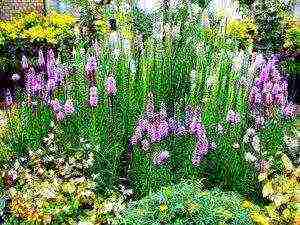 Low-growing varieties of Liatris look surprisingly harmoniously among the strong boulders in rockeries. The most suitable variety for rockeries is "Kobold", since it grows up to 40 cm and has bright purple and violet-purple inflorescences. As an excellent background, lyatrice will serve in rockeries for the Carpathian bell and gray-blue fescue, complementing and shading them.
Low-growing varieties of Liatris look surprisingly harmoniously among the strong boulders in rockeries. The most suitable variety for rockeries is "Kobold", since it grows up to 40 cm and has bright purple and violet-purple inflorescences. As an excellent background, lyatrice will serve in rockeries for the Carpathian bell and gray-blue fescue, complementing and shading them.
Another option for using decorative liatris is longitudinal plantations along fences, flower beds or outbuildings.
Liatris came to us from the gardens of North America relatively recently, so you can rarely find him in the flower beds of neighboring yards. However, such underestimation in this wonderful flower is completely unjustified. In addition to being unpretentious in care and easy to grow, this flower has an original look and excellent aroma.
> > > > > > >


